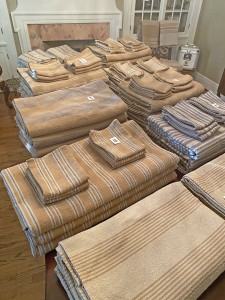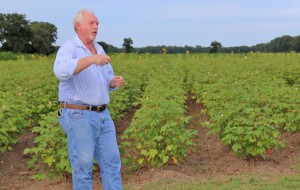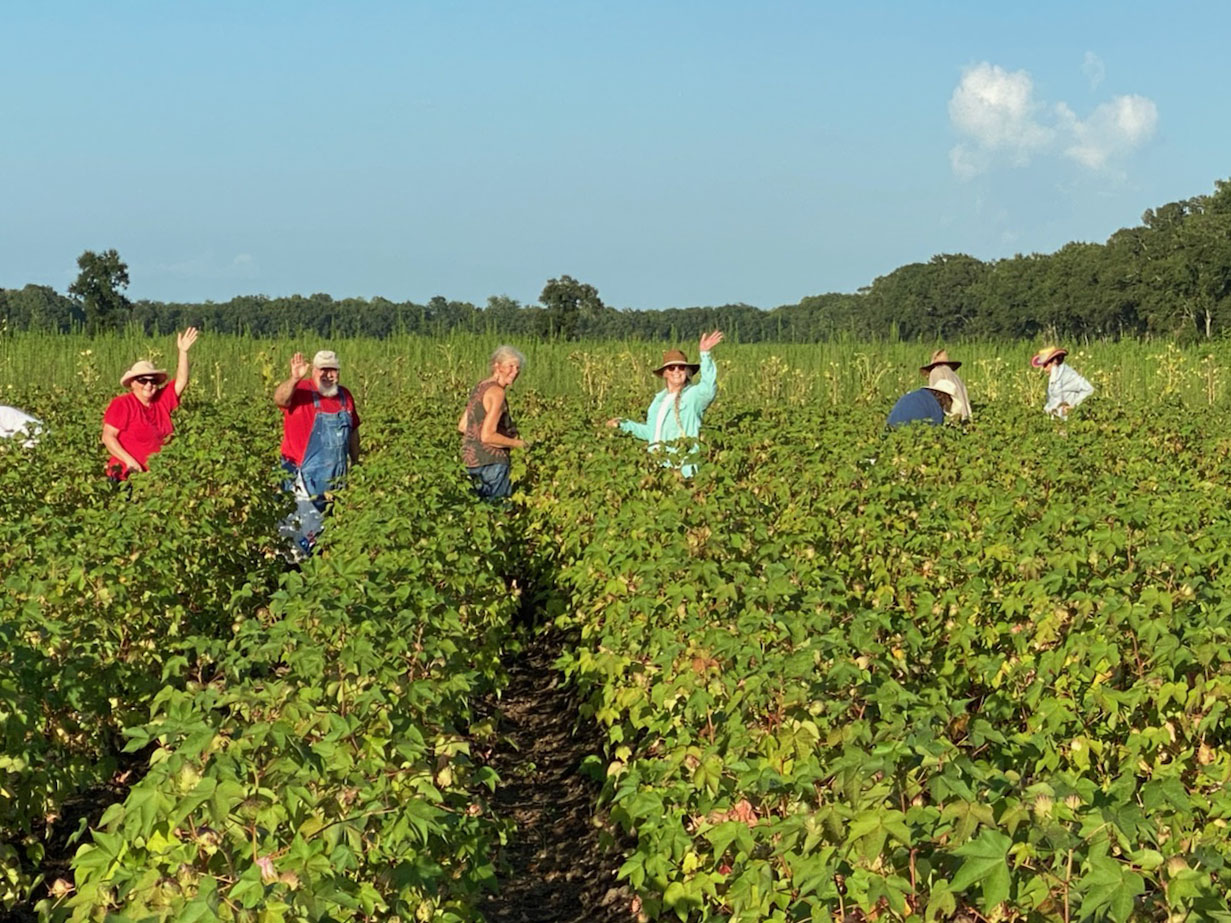ARNAUDVILLE — This season’s first picking of Acadian brown cotton yielded about 65 pounds from a 1/2-acre patch outside Arnaudville last weekend, where a group of friends defied the summer heat to harvest the cotton by hand.
“It’s hot but fun with everyone,” said Jerry Hale, a descendant of cotton farmers who has become an ambassador for coton jaune, the heirloom variety cultivated for 200 years by the Cajuns of the south Louisiana prairies. “We pick about an hour and then sit, talk and enjoy your favorite beverage with snacks.”
Hale is one of a growing number of people cultivating Acadian brown cotton to provide raw materials for artisans who use traditional methods to card, spin and weave the fibers into blankets and other textiles in the manner of their Cajun ancestors. Those labor-intensive endeavors pay tribute to the resilience of the Acadians who arrived in Louisiana after being exiled from Nova Scotia by the British in the 1760s. The Acadians were skilled weavers of woolen fabrics, who adapted to growing and weaving brown cotton, techniques that were handed down through generations of Cajun women until the mid-20th century.
The growers, spinners and weavers are not only replicating the traditional striped patterns of Cajun blankets and fabrics, but also preserving the spirit of community and connection that is a hallmark of Cajun culture.
“We are trying to capture a small portion of that history and teach people about it,” Hale said.
Hale’s Acadian brown cotton, which is planted, cultivated and picked entirely by hand, is in high demand by weavers not only in Louisiana, but elsewhere in the U.S. and Europe, where it is valued for its organic, chemical-free qualities and natural hues. While white cotton sells for about 60 cents per pound, brown cotton sells for $20 per pound.
The revival of growing and weaving brown cotton is one aspect of a larger movement taking place in Arnaudville, a quiet town on Bayou Teche, to preserve Acadian language and culture. Hale got involved through Mavis Arnaud Frugé, an 82-year-old activist who is incorporating spinning and weaving into programs offered at the developing St. Luc French Immersion program. Frugé has spearheaded numerous cultural outreach projects focused on education, language, arts, music, economics and social development.
Hale plowed and planted his fields by hand the first week of April with seedlings appearing in mid-May. When blooms appeared in July, he and Frugé invited friends, artists, historians and anyone interested in Cajun culture to visit the fields that were speckled with pink and white blossoms. He spoke about the growing process, which is sustainable and regenerative, and the significance of brown cotton textiles in Cajun families and communities.
Nearby tables held baskets of coton jaune and stacks of Acadian brown cotton blankets, throws, placemats, napkins and runners for sale. Each piece is sold with numbered tickets that connect the weaver and buyer to give provenance to each handwoven item.
“I enjoy telling people about the history of cotton and how agriculture works,” Hale said. “It’s very time consuming.”
Cotton has been an intrinsic part of Louisiana’s history and economy since the early 18th century. As part of the mallow family, cotton is botanically related to okra and hibiscus which thrive in tropical/subtropical regions and is fairly easy to grow. Originally cultivated mainly for home spinning and weaving, the invention of the cotton gin vaulted cotton into a cash crop that was just as profitable for small farmers as it was for large-scale planters; therefore many Louisiana farmers raised cotton.
White cotton supplanted brown cotton in popularity because it has fewer seeds, is easier to gin and can be dyed a variety of colors, as opposed to the natural tan, buff and butternut shades of coton jaune. Brown cotton fibers are also shorter and harder to comb and spin. Cajun farmers would grow white cotton to sell and brown cotton for home use in blankets, bedding and clothing.
“Brown cotton is like okra and will keep reproducing,” Hale said. “Last year, we picked seven times in the season. As long as you pick it, it will keep making, but you do lose some color later in the season. It’s a lot of labor.”
The labor also brought families and communities together.
“The early Acadians didn’t have cotton gins. They removed seeds by hand and as a communal people, it was a communal activity,” Hale said. “Cajuns would have a party to deseed the cotton with people bringing food and musicians entertaining families. We hope to revive that, along with teaching people about the cotton and its history.”
Cultivating coton jaune, spinning and weaving it into textiles is not just about preserving an artform, but also creates tangible connections to the past and future. Upon marriage, a Cajun girl would receive a number of handwoven items for her new home, with some surviving today as treasured family heirlooms. Contemporary spinners and weavers often use spinning wheels and looms from the 19th century to create blankets that will be passed down to future generations.
A landmark exhibition featuring coton jaune and brown cotton textiles will open at Lafayette’s Hilliard Art Museum on Sept. 11 and run through June 30, 2021. “Acadian Brown Cotton: The Fabric of Acadiana” will include stories and information on the cultural tradition of farming and weaving brown cotton and how it relates to Acadian genealogy, economics and folklore. Information on the exhibition is available at http://www.hilliardmuseum.org/exhibits/acadian-brown-cotton-the-fabric-of-acadiana.
More information about Acadian brown cotton is available at www.acadianbrowncotton.com and Facebook.com/acadianbrowncotton. Information on St. Luc is available at stlucimmersion.org. Hale can be reached at (337) 446-3814. He is a 1979 graduate of Northwestern State University.
A link to a previous story on Acadian brown cotton can be found here: https://www.nsula.edu/growers-artisans-reviving-tradition-of-acadian-brown-cotton/

Blankets and throws made from Acadian brown cotton are woven with traditional striped patterns.

The first Acadian brown cotton harvest of 2020 yielded about 65 pounds from a ½-acre patch. Brown cotton will continue to produce through late fall. (Photo by Jerry Hale)

Jerry Hale welcomed visitors to a patch of Acadian brown cotton in bloom and explained the sustainable growing process.

